Overview
The central question explored in this article is how veterans can obtain free nexus letters to enhance their chances of success in VA claims. We understand that navigating this process can be overwhelming, but knowing the requirements for nexus letters and leveraging resources like AI-powered platforms can significantly simplify your journey. By doing so, you can bolster the credibility and effectiveness of your claims. Remember, you are not alone in this endeavor; we’re here to help you every step of the way.
Introduction
Navigating the complexities of the VA claims process can feel overwhelming for veterans, especially when it comes to securing specific documentation like nexus letters. We understand that these critical documents act as a vital link between a veteran's medical conditions and their military service, playing an essential role in the approval of disability claims. However, it’s common to feel uncertain about how to obtain these letters without facing high costs or bureaucratic challenges.
What strategies can you use to secure free nexus letters that boost your chances of success? In this article, we outline ten essential steps designed to simplify the nexus letter process, empowering you to advocate for your rightful benefits with confidence. You're not alone in this journey, and we're here to help.
Turnout: Streamline Your Nexus Letter Process with AI-Powered Advocacy
Navigating the VA application process can be overwhelming for many former service members. We understand that acquiring the necessary documentation can feel daunting. That's where Turnout steps in, utilizing AI technology to simplify the process of creating free nexus letters. By automating administrative tasks and providing real-time updates, Turnout allows you to focus on what truly matters—your health and well-being.
This innovative approach not only shortens processing times but also enhances your overall experience. With Turnout, you can maneuver through the often-challenging VA application process with renewed confidence. Imagine having trained non-legal advocates for SSD applications and partnering with IRS-licensed enrolled agents for tax debt relief, ensuring you receive qualified assistance every step of the way.
In 2025, the VA reported an average processing time for disability claims of just 94.8 days—a remarkable improvement thanks to technological advancements, including AI-driven solutions. As platforms like Turnout continue to innovate, you can expect even more efficient services that enhance your access to the benefits you’ve earned. Remember, you are not alone in this journey; expert assistance is available without the necessity for legal representation. We're here to help you every step of the way.
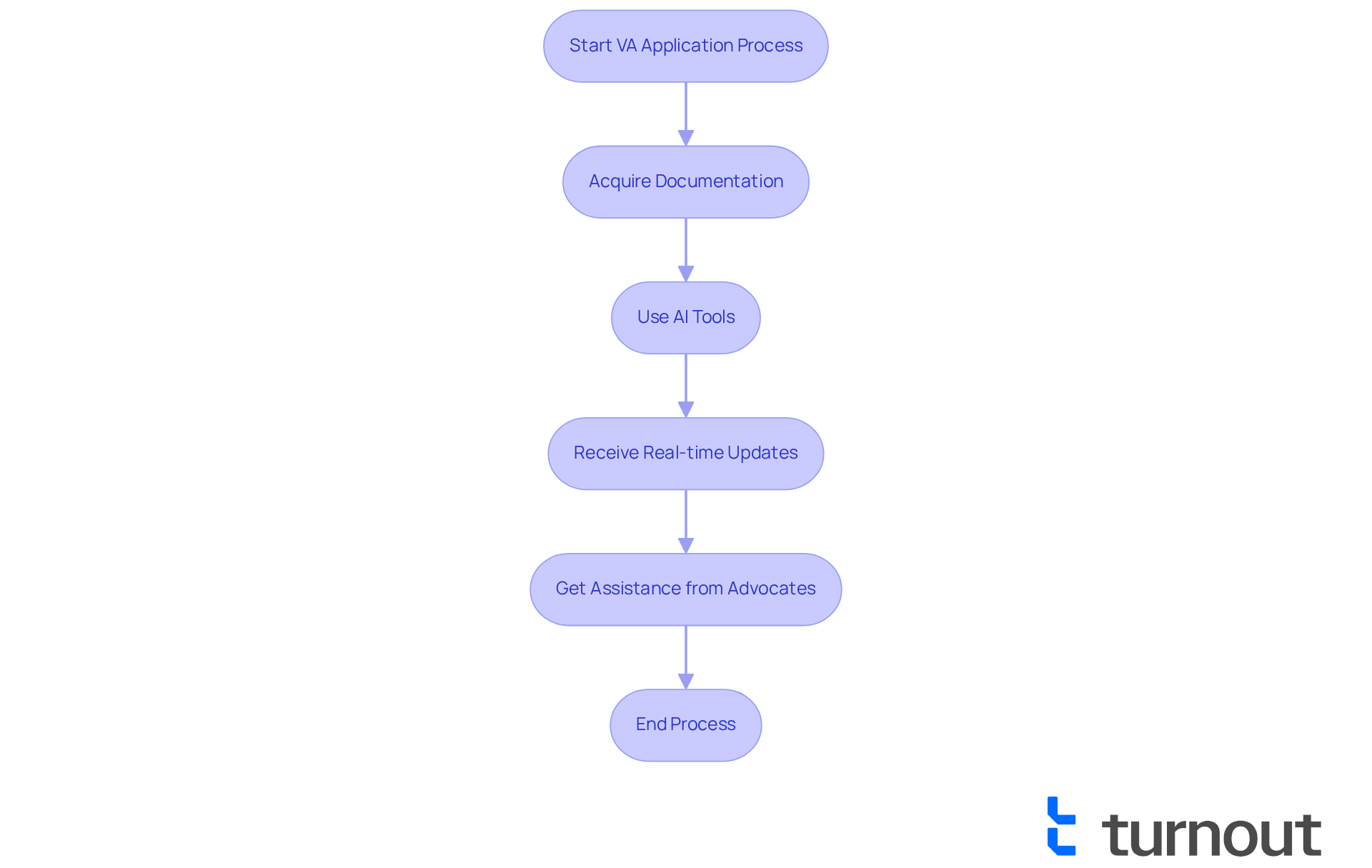
Understand VA Nexus Letter Requirements for Successful Claims
A nexus document plays a crucial role in connecting a service member's current medical condition to their military service. It’s essential to understand that this document must include:
- A detailed medical history
- A thorough examination of the individual's condition
- A professional opinion that links the two
Specifically, the document should detail the veteran's diagnosis, symptoms, and provide a clear rationale stating it is 'at least as likely as not' that the condition is related to military service. This language is vital, as it significantly boosts the chances of approval.
We understand that navigating the VA claims process can be overwhelming. Research indicates that many rejections stem from a lack of free nexus letters or from having an inadequate connection document. This underscores the importance of a well-prepared connection document, such as free nexus letters, in your claims process. Veterans should ensure that this document is crafted by a qualified medical professional who is well-versed in their specific disabilities, enhancing credibility and strengthening the case.
It's also important to consider the potential costs involved in obtaining a connection document, which can range from $400 to over $2,000. As you pursue this essential paperwork, we encourage you to weigh these expenses thoughtfully. Grasping these prerequisites is key for former service members to ensure that their submissions are not only filed but also have a strong likelihood of acceptance. Remember, you are not alone in this journey; we’re here to help you every step of the way.
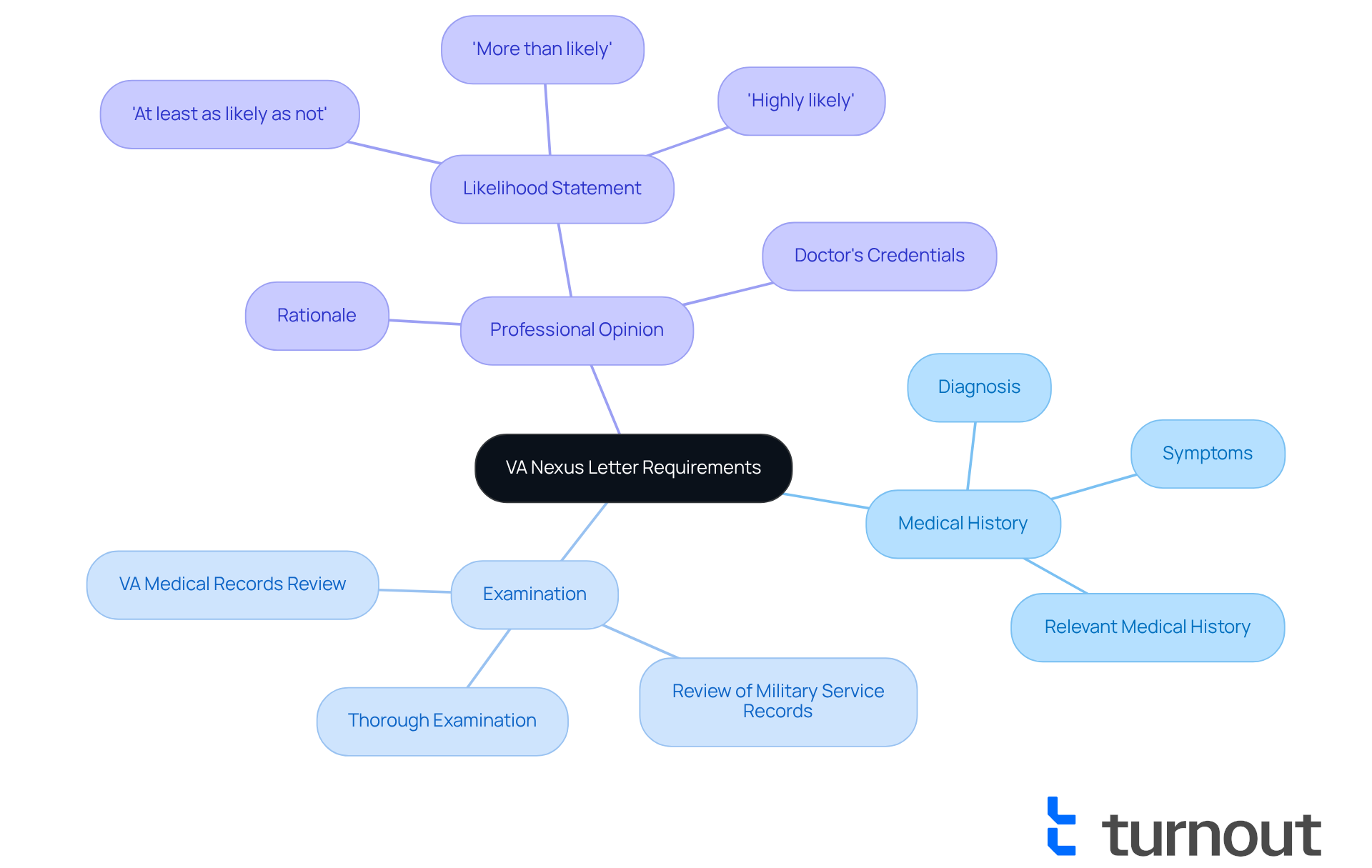
Find Qualified Professionals to Write Your Nexus Letter
To secure a solid connection document, former military personnel are encouraged to seek out experts who can provide free nexus letters and have a proven track record in VA claims, as well as a thorough understanding of connection document criteria. Ideal candidates include licensed healthcare providers such as:
- Physicians
- Psychologists
- Nurse practitioners
- Physician assistants
who have experience treating the individual’s condition. We understand that interacting with military organizations can open up valuable networking opportunities. Additionally, resources like Turnout can connect service members with skilled professionals who are proficient in crafting free nexus letters.
The average cost for obtaining a nexus letter typically hovers around $1,500. This fee generally includes a comprehensive review of medical records and the drafting of the letter. However, it’s important to note that costs may vary depending on the complexity of the case and the specialties involved. For instance, if multiple conditions are addressed, the same fee might cover several issues, making it a more cost-effective option.
Effective partnerships between former service members and healthcare professionals often hinge on clear communication and a shared understanding of the individual’s medical history. Many former service members who have worked with experts knowledgeable about VA standards have reported significantly improved outcomes in their applications. By ensuring that the chosen service provider is well-versed in the intricacies of VA disability applications, former service members can enhance their chances of receiving the benefits they deserve. Remember, you are not alone in this journey; we’re here to help you navigate the process.
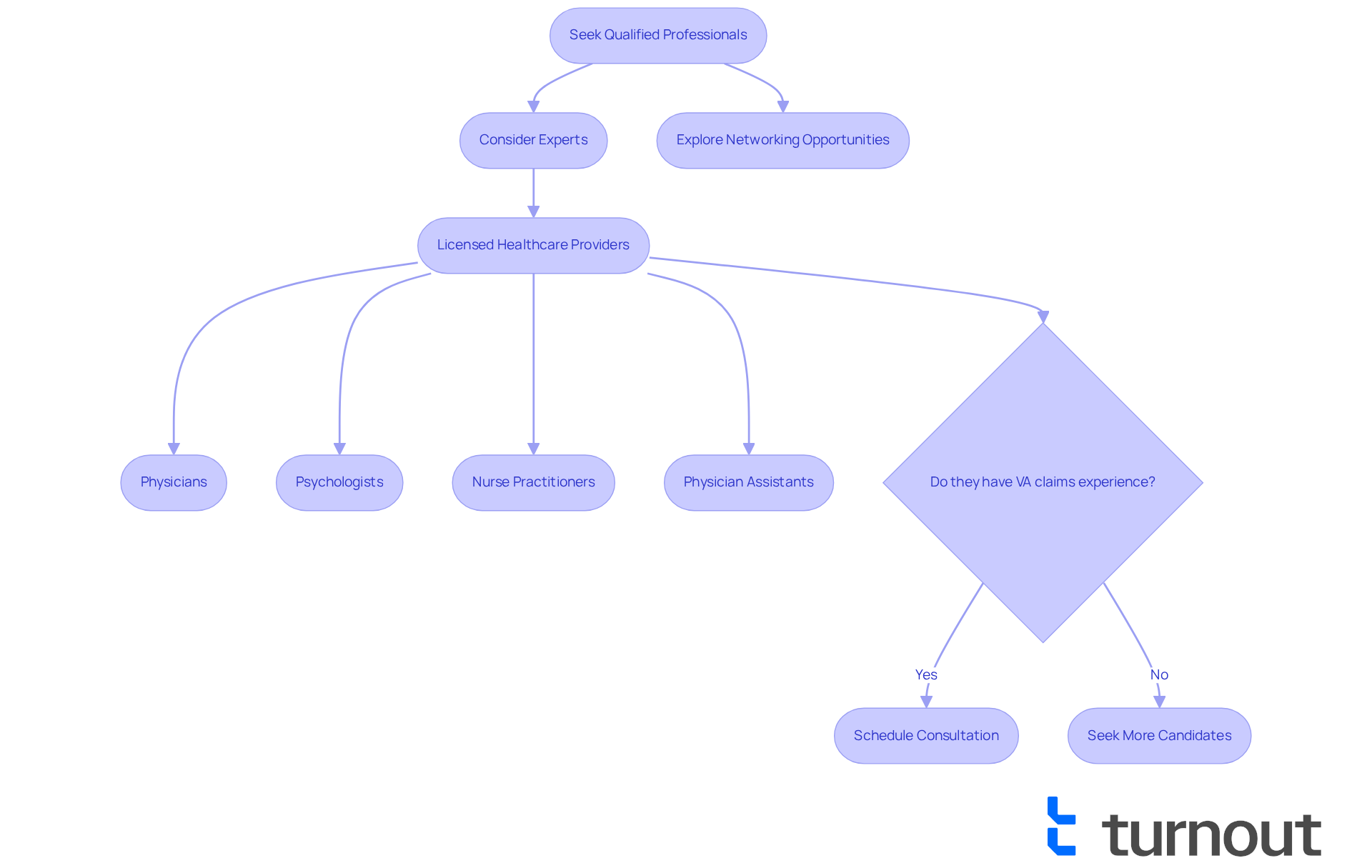
Address Physician Refusals: Steps to Take for Your Nexus Letter
When a healthcare provider declines to compose free nexus letters, we understand that this can be frustrating for veterans. It’s important to first strive to comprehend the fundamental reasons for the rejection. Engaging in open communication can often clarify misunderstandings and lead to a resolution. If the doctor remains reluctant, seeking a second perspective from another skilled healthcare provider who understands the VA application process might be helpful.
Documenting all interactions with healthcare providers is crucial. This record can support further actions if necessary. Typical causes for denials often include:
- An unfamiliarity with the documentation requirements
- Worries regarding the authenticity of the claim
- Time limitations
Veterans should approach their healthcare providers with a clear description of the significance of free nexus letters and how these documents relate their medical condition to military service.
It is also vital to emphasize that persuasive medical proof should back the connection document, as this enhances the case. Any certified healthcare practitioner can compose a connection document, but the VA prefers it to be created by specific experts who utilize free nexus letters. Furthermore, former service members should be aware of the possible expenses linked to acquiring a connection document, which can vary from $600 to $5,000.
By promoting a cooperative conversation and steering clear of legal disputes in the correspondence, veterans can enhance their opportunities for obtaining the vital documentation required for their requests. Remember to clearly express the purpose of the document, and consider these actionable steps when encountering physician refusals. You are not alone in this journey; we’re here to help you navigate through these challenges.
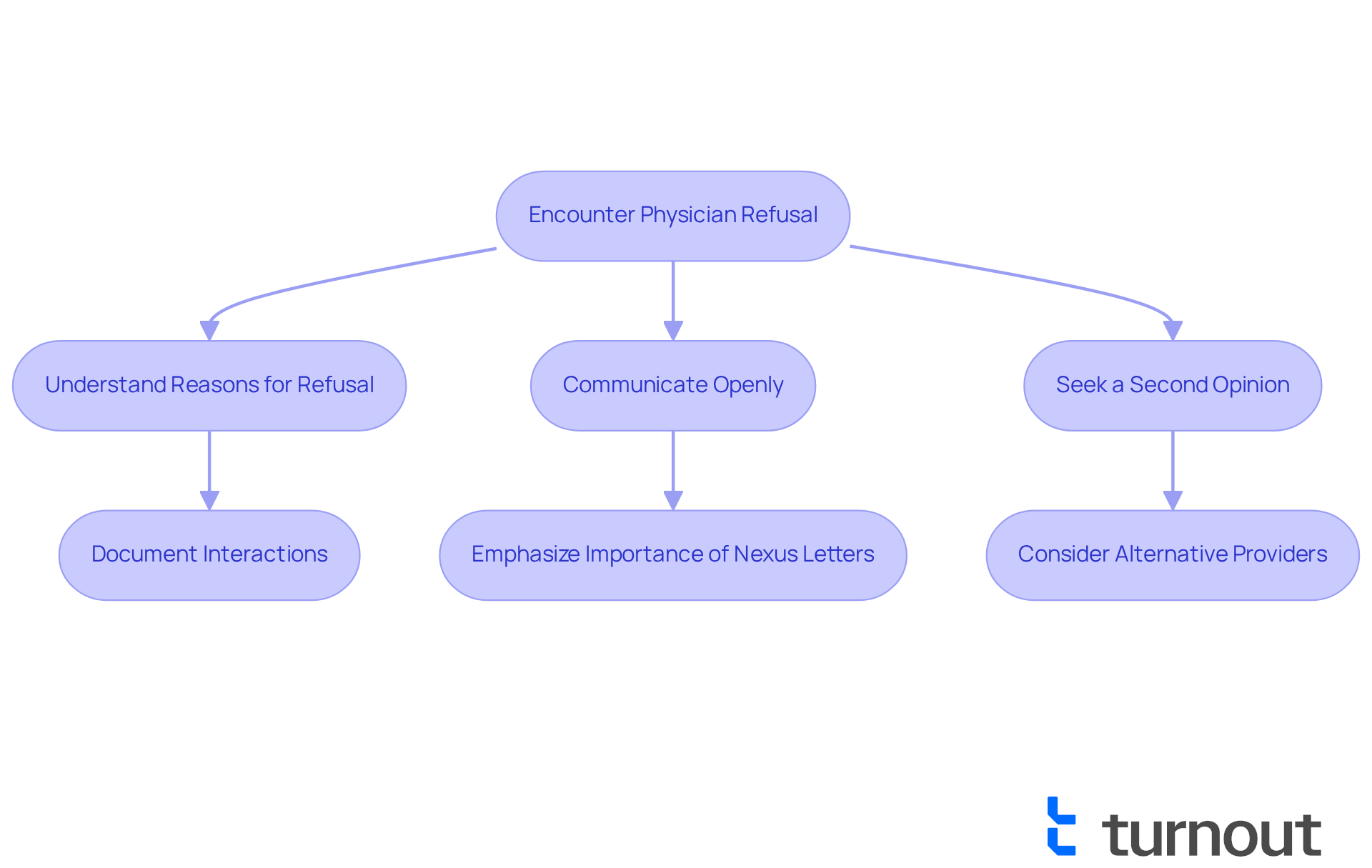
Explore Common Questions About VA Nexus Letters
Veterans often have questions about the connection document process. What should be included? How long does it take to get one? Can a document from a previous submission be reused? Addressing these inquiries can empower former service members with the knowledge they need to navigate their claims effectively.
- What to Include in a Nexus Document: A well-constructed nexus document should feature a clear medical opinion linking the individual's current health condition to their military service. It should include a review of the individual's medical history, specific service records, and a detailed explanation of how the in-service event caused or worsened the condition. Importantly, the document must indicate that no additional risk factors contributed to the veteran's condition, strengthening the connection to military service. Free nexus letters serve as essential supportive materials for VA disability requests, making them crucial for a successful application.
- Average Time to Obtain a Connection Document: The time needed to secure a connection document can vary greatly, usually ranging from a few days to several weeks. This fluctuation often depends on the healthcare provider's availability and the complexity of the situation. Veterans are encouraged to prepare properly and start the process early to avoid delays in their requests.
- Utilizing Prior Correspondence: While it is possible to use a document from an earlier submission, it is crucial to ensure that it remains relevant and meets the current submission's criteria. If the individual's situation has changed or new information has emerged, an updated document may be necessary to strengthen the case. Not all doctors are comfortable or have the opportunity to write a connection document, which can pose challenges for former service members.
It's important to understand that while a connection document can enhance the chances of a favorable outcome, it does not guarantee success. Additionally, veterans should be aware of the potential costs associated with obtaining a connection document, which can vary significantly. Consulting with qualified documentation providers can improve their chances of securing free nexus letters for VA benefits. Ideally, a connection document should be submitted alongside the initial VA request or with an appeal if the request was denied. Understanding these elements is essential for former service members as they manage their applications. Remember, you're not alone in this journey; we're here to help.
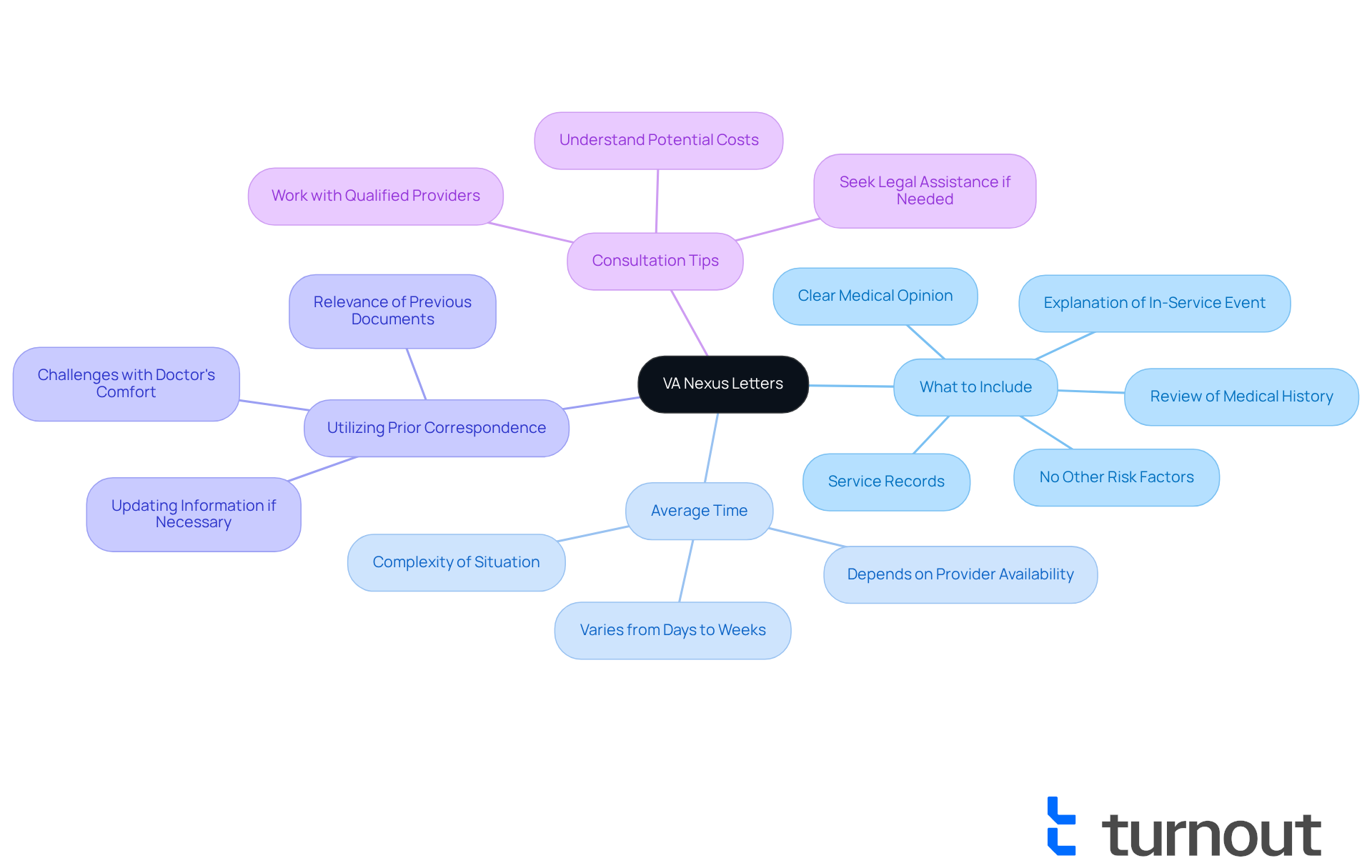
Determine When You Need a Nexus Letter for VA Claims
A connection document is essential for veterans seeking recognition for a service-related impairment, particularly when the condition wasn’t documented during service or its link to military duty is uncertain. Many veterans face challenges that often require free nexus letters for conditions like PTSD, chronic pain, and various mental health issues that may not be reflected in service treatment records. It’s important for veterans to recognize specific circumstances that necessitate free nexus letters, such as:
- When a diagnosis emerges after discharge
- When a request has been denied due to insufficient evidence
- When applying for secondary conditions related to an already acknowledged disability
For instance, if a former service member's military records do not mention their current medical issue, obtaining a supportive document can significantly strengthen their case. A well-crafted document that includes free nexus letters provides comprehensive medical reasoning and establishes a vital connection between the individual’s disability and their military service. This can be crucial in overturning denied requests.
Experts emphasize the importance of these documents: "A connection document must rely on an assessment of the individual’s military medical records and offer a clear viewpoint on the probability of the disability being related to service." Additionally, successful requests often hinge on the inclusion of free nexus letters, especially in complex cases where initial submissions have faced rejection. By understanding when to request a connection document, former service members can better prepare their submissions and enhance their chances of approval. Remember, you are not alone in this journey—we're here to help you navigate these challenges.
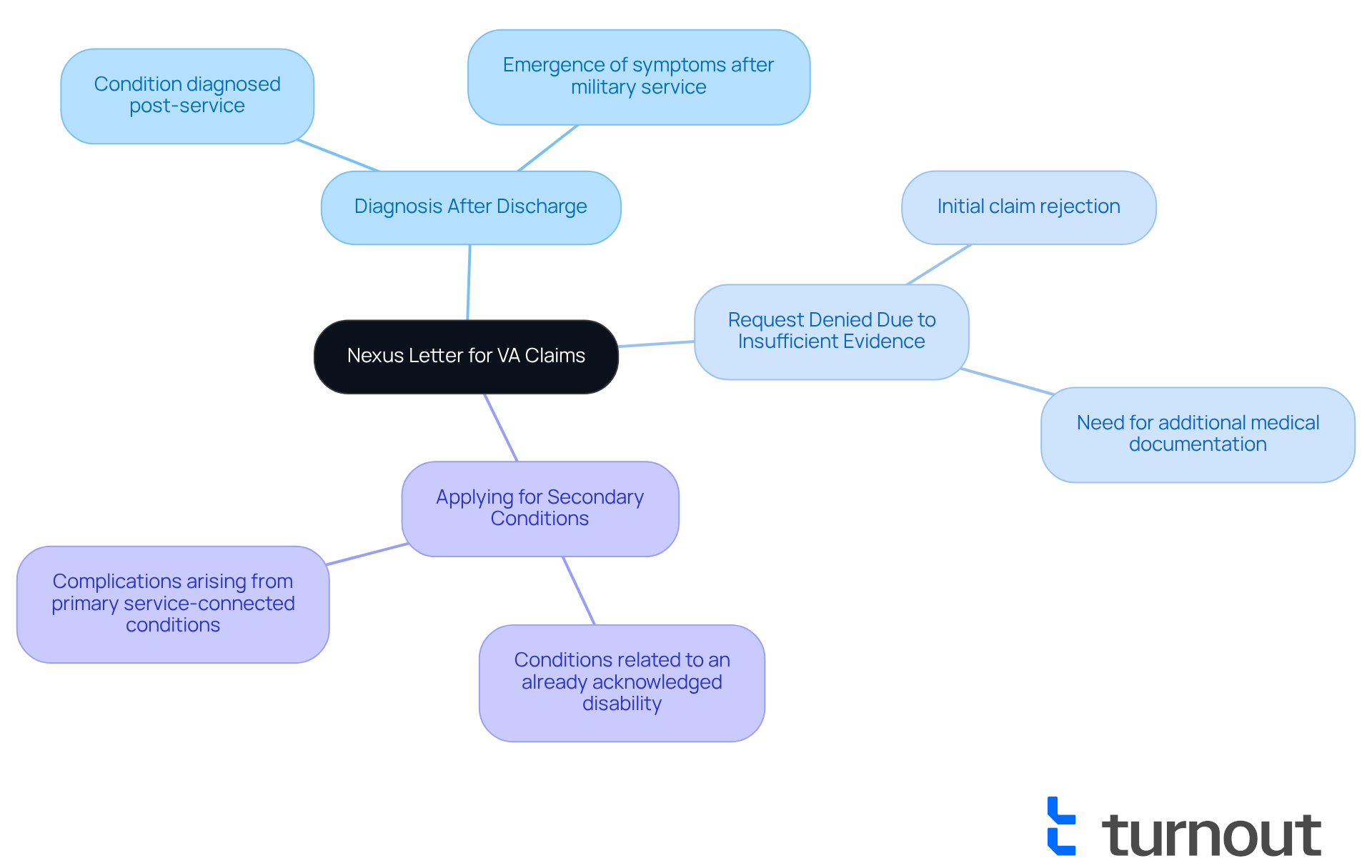
Evaluate the Impact of Nexus Letters on VA Appeal Success
The success of VA appeals relies heavily on free nexus letters. They provide the crucial medical proof needed to support a veteran's request for free nexus letters, particularly when initial submissions were denied due to insufficient evidence. A well-crafted document, including free nexus letters, can significantly strengthen an appeal, improving the chances for the VA to review the request favorably.
We understand that many veterans face challenges in securing their benefits. Data shows that numerous VA disability benefits requests are denied because of inadequate proof of service connection. This highlights the importance of free nexus letters as connection documents in the appeals process. A persuasive connection document not only bolsters the appeal but also addresses potential weaknesses in the original claim by incorporating free nexus letters. As noted by QRF Legal Services, "A connection document is a written statement or record created by a healthcare professional... that offers a qualified and informed medical opinion regarding a service member’s injury, illness, or medical condition and its relation to military service."
For instance, in the case study titled 'Success Story of VA Disability Appeal,' veterans who included detailed correspondence in their appeals successfully overturned previous denials. This demonstrates how effective correspondence can establish a clear link between military service and health issues.
Furthermore, incorporating free nexus letters as supporting medical evidence within these documents enhances their credibility, making them vital to the appeals process. It is crucial that these documents are created by certified medical professionals to ensure their legitimacy. As you navigate the complexities of your requests, recognizing the strategic importance of free nexus letters can greatly improve your chances of receiving the benefits you deserve.
We also acknowledge that obtaining a connection document can incur costs ranging from $400 to $2,000, which is a significant consideration for many veterans. Remember, you are not alone in this journey; we’re here to help you every step of the way.
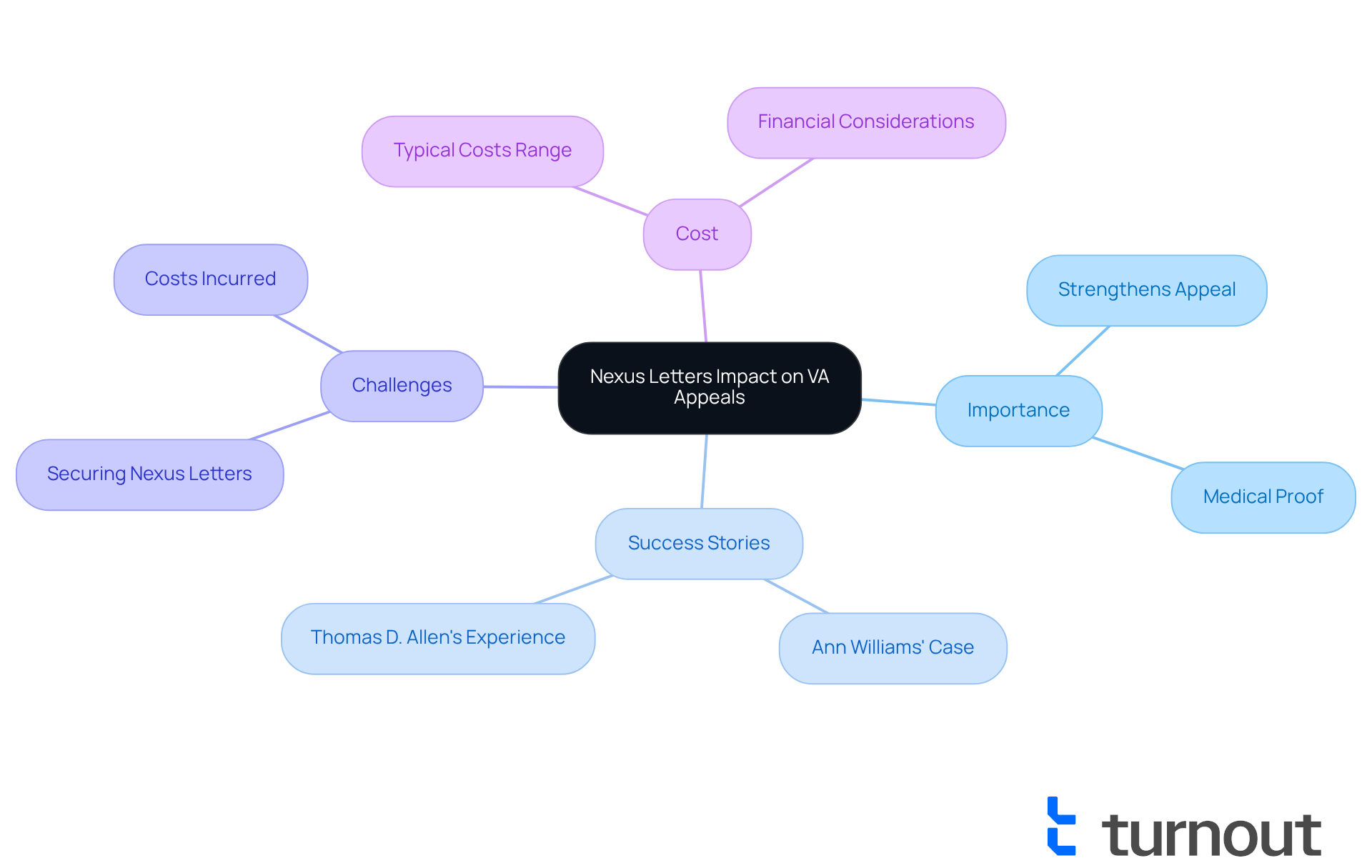
Timing Your Nexus Letter Submission for Optimal Results
Providing a connection document at the right moment can significantly influence the outcome of your VA request. We understand that navigating this process can be challenging, so veterans should strive to attach the connection document with their initial submission whenever possible. This proactive step helps establish a strong link between your condition and military service right from the start.
If you find yourself submitting during an appeal, it's crucial to ensure that the document arrives before the appeal hearing. This allows the VA ample time to review the new evidence, which can be pivotal in overturning previous denials. A well-timed document not only clarifies the medical connection but also demonstrates your commitment to your claim, increasing the likelihood of a positive outcome.
According to specialists, "Obtaining robust proof such as a VA connection document early establishes the groundwork for a possibly easier procedure and may even assist in preventing needless hold-ups in receiving your disability benefits." Furthermore, including current medical records and clearly stating that your condition is 'at least as likely as not' related to military service is essential for a strong connection statement.
Always aim to provide your supporting document with your initial submission. By doing so, you bolster your case from the very beginning, knowing that we're here to help you every step of the way.
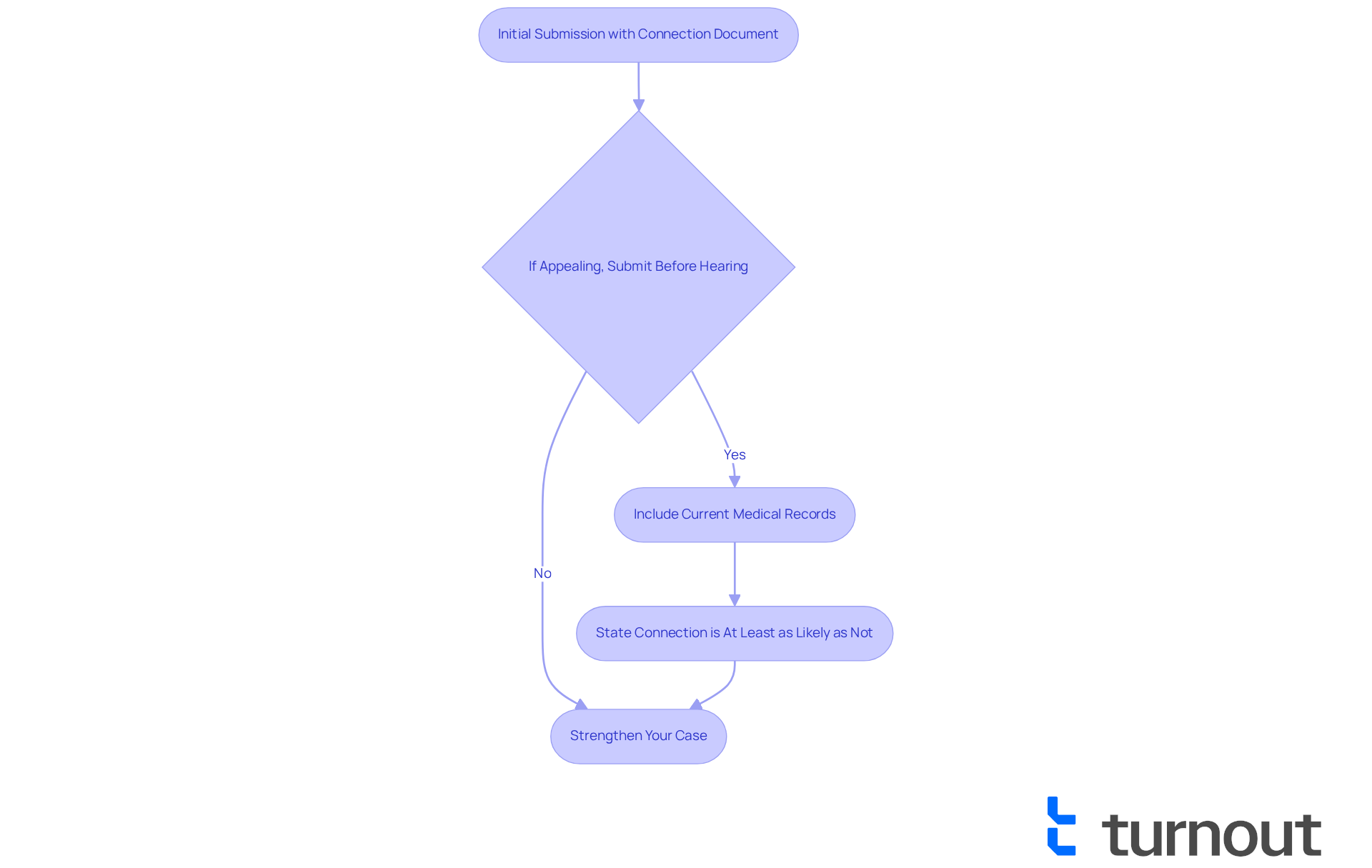
Navigate Claim Denials: What to Do with a Nexus Letter
When faced with a denial of benefits, we understand that former service members may feel overwhelmed. It's essential to carefully examine the rejection notice to grasp the fundamental reasons behind the decision. Free nexus letters can serve as a vital resource in this situation, directly addressing the specific issues highlighted by the VA. By including free nexus letters in their appeal, service members can effectively illustrate how they support their argument and counter the reasons for rejection.
In 2025, the VA managed over one million disability requests, reflecting a 15.6% rise in new submissions that year. This surge underscores the challenges veterans encounter in navigating a complex system. It's common to feel frustrated, but the typical success rate for appeals utilizing additional submissions—often containing new information like connection documents—is approximately 50%. Notably, over 60% of claims were approved by the VA, suggesting that a carefully constructed connection document can significantly impact the outcome of an appeal.
Veterans have shared their experiences regarding the effectiveness of connection documents. One veteran expressed, 'The connecting document was crucial in my appeal; it distinctly associated my condition with my service, which the VA initially failed to acknowledge.' Such testimonials highlight the importance of ensuring that the connection document is thorough and directly addresses any opposing evidence cited by the VA. Moreover, Ursula Mecabe points out the systemic challenges within the VA claims process, emphasizing the need for a strong connection document to navigate these hurdles.
The success rates of appeals that include connection documents are indeed promising. For instance, former service members who provided comprehensive connection documents with their appeals reported a greater likelihood of obtaining the benefits they deserve. This trend underscores the importance of acquiring a formal document from a qualified medical expert who can articulate the relationship between the veteran's condition and their military service.
In conclusion, a connection document is not just a formality; it is a crucial piece of evidence that can greatly enhance the chances of a successful appeal. We encourage veterans to leverage this tool effectively as they navigate the complexities of the VA claims process. Additionally, seeking assistance from Veterans Service Organizations (VSOs) or accredited professionals can provide valuable support in this journey. Remember, you are not alone in this process; we're here to help.
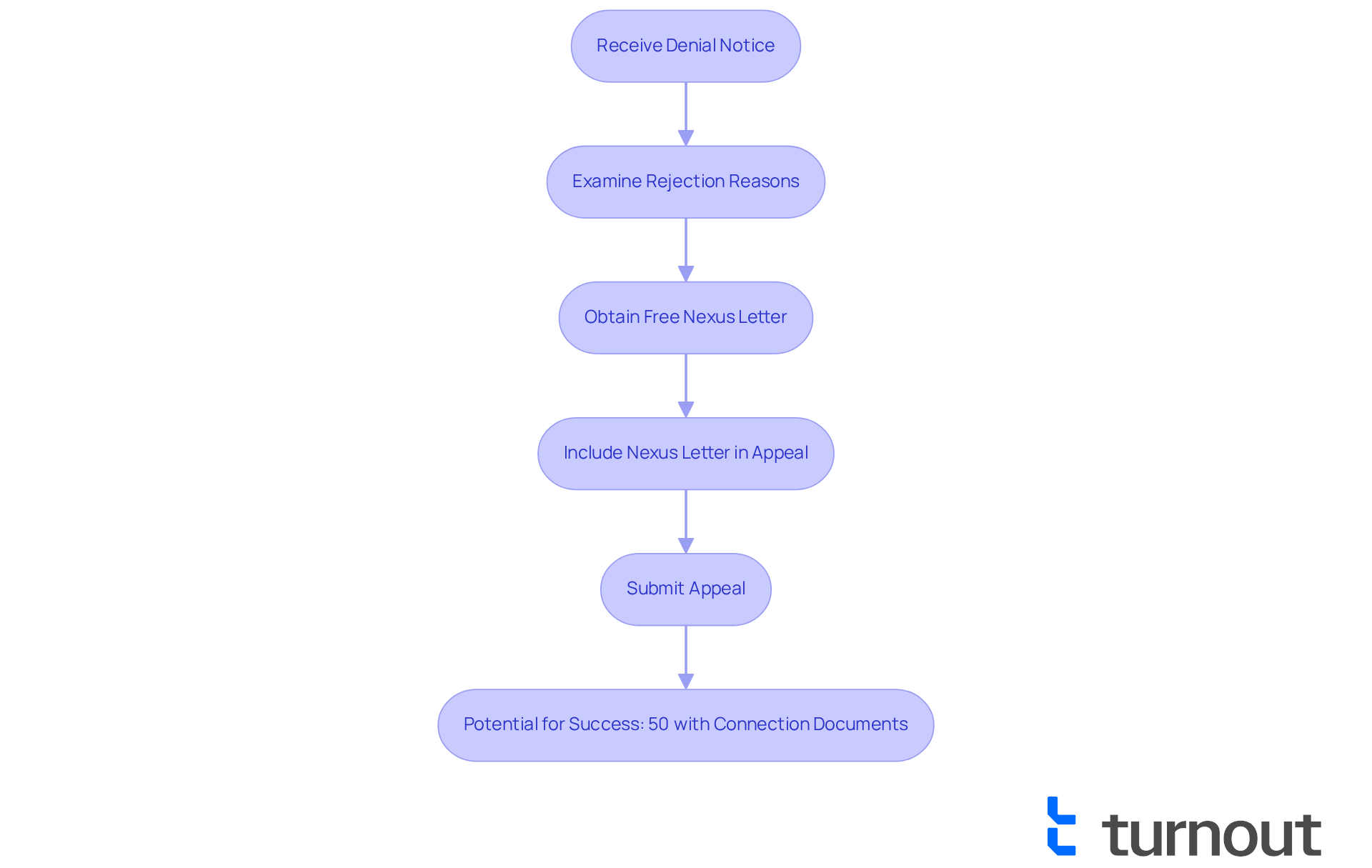
Review Effective Nexus Letter Examples for Your VA Claims
Analyzing successful connection document samples can truly empower service members to organize their own documents effectively. It's essential to include components such as:
- A clear statement of the individual's medical condition
- A thorough explanation of how this condition relates to military service
- A professional opinion from a qualified healthcare provider
These examples not only illustrate the required format but also serve as valuable models, helping individuals create persuasive correspondence that can significantly enhance their chances of a successful claim.
Statistics show that well-organized correspondence, which clearly articulates the link between a service member's condition and their duty, can lead to an average rating increase of 30% for those completing the Elite program from VA Claims Insider. Helpful phrases for the connection document, like 'more likely than not' and 'at least as likely as not,' are crucial for articulating the relationship between the individual's condition and military service.
We recommend providing the connection document as early as possible in the claims process, as this can positively influence the outcome. Additionally, it's important for former service members to know that obtaining a connection document may involve costs ranging from $1,500 to $2,000, though reduced rates are available through initiatives such as the VA Claims Insider Elite program.
A strong connection document should also detail the individual's relevant medical history, including military service records and any private healthcare received. While a well-crafted free nexus letter can be a significant asset in achieving favorable determinations, it does not guarantee success. By following these guidelines and utilizing available templates, veterans can enhance their submissions and navigate the claims process with greater confidence. Remember, you are not alone in this journey, and we’re here to help you every step of the way.
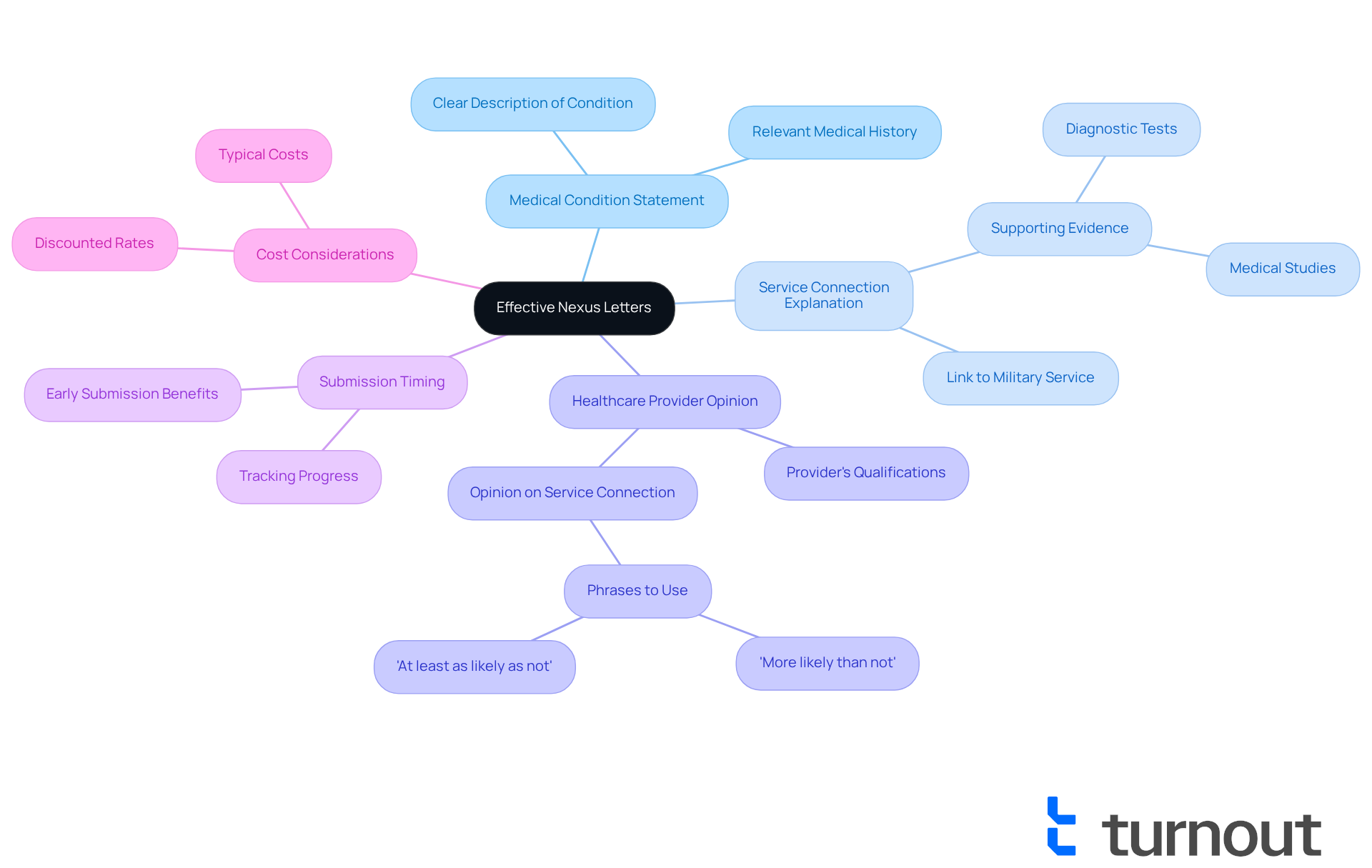
Conclusion
Navigating the complexities of the VA claims process can feel overwhelming for veterans. We understand that the journey may seem daunting, but recognizing the critical role of nexus letters can significantly enhance your chances of success. These documents serve as vital links between your current medical conditions and your military service, making them essential for securing the benefits you have earned.
Innovative solutions like Turnout can help streamline the process of obtaining free nexus letters. This ensures that you receive the support you need without the burden of excessive costs. It’s common to feel uncertain about where to start, but know that there are resources available to guide you.
Throughout this article, we highlighted key insights, emphasizing the importance of a well-prepared nexus letter that meets specific VA requirements. These letters should ideally be crafted by qualified professionals who understand the nuances of the VA application process. Addressing common challenges, such as physician refusals and the timing of submissions, can empower you to navigate your claims more effectively.
Remember, securing a nexus letter is not just a procedural step; it is a crucial component in your journey toward obtaining rightful VA benefits. We encourage you to take proactive measures, seek qualified assistance, and leverage the resources available to you. By doing so, you can enhance your chances of success and ensure that your voice is heard in the claims process.
Support is available, and every step taken toward obtaining a nexus letter is a step toward achieving the benefits that honor your service. You are not alone in this journey, and together, we can work toward a brighter future.
Frequently Asked Questions
What is the purpose of Turnout in the VA application process?
Turnout utilizes AI technology to simplify the process of creating free nexus letters, helping former service members navigate the VA application process more efficiently.
How does Turnout improve the VA application experience?
Turnout automates administrative tasks and provides real-time updates, allowing users to focus on their health and well-being while shortening processing times and enhancing the overall experience.
What is a nexus document and why is it important?
A nexus document connects a service member's current medical condition to their military service. It is crucial for VA claims as it includes a detailed medical history, examination of the condition, and a professional opinion linking the two.
What specific information must be included in a nexus letter?
A nexus letter must detail the veteran's diagnosis, symptoms, and provide a clear rationale stating that it is 'at least as likely as not' that the condition is related to military service.
What are the potential costs of obtaining a nexus letter?
The costs for obtaining a nexus letter can range from $400 to over $2,000, depending on the complexity of the case and the specialties involved.
Who should former military personnel seek for writing their nexus letters?
They should seek licensed healthcare providers such as physicians, psychologists, nurse practitioners, or physician assistants who have experience treating their specific conditions.
How can Turnout assist in finding qualified professionals for nexus letters?
Turnout can connect service members with skilled professionals proficient in crafting free nexus letters, enhancing their chances of successful claims.
What impact does working with knowledgeable professionals have on VA claims?
Many former service members have reported significantly improved outcomes in their applications when working with experts knowledgeable about VA standards.




